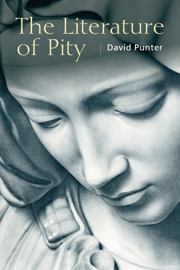Book contents
- Frontmatter
- Contents
- Plates
- Preface
- Acknowledgements
- 1 Distinguishing Pity
- 2 Pity and Terror: The Aristotelian Framework
- 3 Pietà
- 4 Shakespeare on Pity
- 5 The Eighteenth Century
- 6 Blake: ‘Pity would be no more …’
- 7 Aspects of Victoriana
- 8 Chekhov and Brecht: Pity and Self-Pity
- 9 ‘War, and the pity of War’: Wilfred Owen, David Jones, Primo Levi
- 10 Reflections on Algernon Blackwood's Gothic
- 11 Pity's Cold Extremities: Jean Rhys and Stevie Smith
- 12 Reclaiming the Savage Night
- 13 ‘Pity the Poor Immigrant’: Pity, Diaspora, the Colony
- 14 Lyric and Pity
- After Thought: Under the Dome
- Notes
- Bibliography
- Index
11 - Pity's Cold Extremities: Jean Rhys and Stevie Smith
Published online by Cambridge University Press: 05 September 2014
- Frontmatter
- Contents
- Plates
- Preface
- Acknowledgements
- 1 Distinguishing Pity
- 2 Pity and Terror: The Aristotelian Framework
- 3 Pietà
- 4 Shakespeare on Pity
- 5 The Eighteenth Century
- 6 Blake: ‘Pity would be no more …’
- 7 Aspects of Victoriana
- 8 Chekhov and Brecht: Pity and Self-Pity
- 9 ‘War, and the pity of War’: Wilfred Owen, David Jones, Primo Levi
- 10 Reflections on Algernon Blackwood's Gothic
- 11 Pity's Cold Extremities: Jean Rhys and Stevie Smith
- 12 Reclaiming the Savage Night
- 13 ‘Pity the Poor Immigrant’: Pity, Diaspora, the Colony
- 14 Lyric and Pity
- After Thought: Under the Dome
- Notes
- Bibliography
- Index
Summary
Jean Rhys's Voyage in the Dark was one of her early novels; published in 1934 to little acclaim, it was only really resurrected when she underwent her curious renaissance in the later 1960s. Read now, it is I think – at least for me – a terrifying book. It tells, I suppose one might say, the story of Anna: lacking parents, in one sense or another, she is brought to England from the Caribbean by her aunt Hester, who effectively abandons her. She drifts from the life of a chorus girl into semi-prostitution, whatever that might mean, and becomes pregnant – she has no idea who the father might be. She undergoes an agonising abortion, whereupon the novel abruptly ends with Anna dreaming of beginning life all over again.
To say that is to suggest that we end our reading of the text on a note of redemption, but this is in fact the opposite of the case. Anna's dream of rebirth is exactly that, a dream: the reader feels at no point that such a rebirth could actually be possible; what has been done has been done and cannot be unravelled. Besides, we have no compelling reason to believe anything Anna says: she spends most of her time, as she and various other characters in the novel say, half-asleep; she is permanently exhausted and spends weeks on end in bed, retreating from the always ‘cold’ world of London and England. It is not that she is a victim: to suppose such would be far too simple. Rhys has an advanced and extraordinary insight into notions of collusion, which I need to try to explain.
- Type
- Chapter
- Information
- The Literature of Pity , pp. 119 - 130Publisher: Edinburgh University PressPrint publication year: 2014



